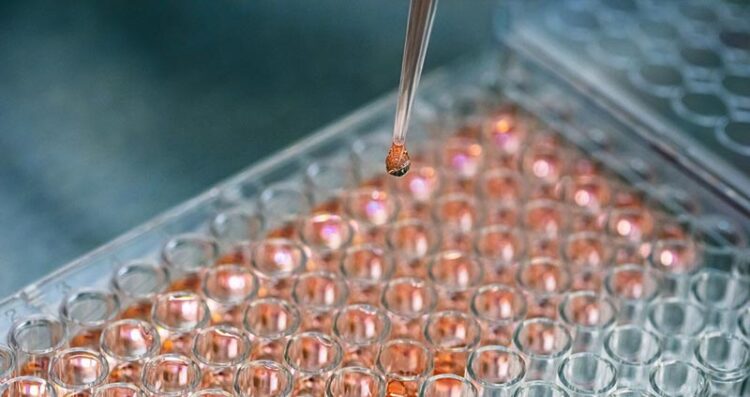Bioreactor keeps cell culture conditions under control

A KAUST team of marine scientists and bioscientists has developed a cell-culturing technique that could lead to more accurate, interpretable and reproducible experiments in biomedical research.© 2022 KAUST; Anastasia Serin
Laboratory parameters maintained at physiologically relevant levels allow for more robust experiments with human cells.
A cell-culturing technique developed by KAUST scientists helps to create biological conditions that more closely mirror physiological environments compared to standard protocols used in most laboratories today.
The new bioreactor system delivers gases — rather than chemicals — to keep acidity levels and oxygen exchange kinetics within body-like ranges, an approach that allows for more careful control of environmental parameters.
It is also more responsive to the metabolic activity of cells and more representative of what happens inside living organisms. If widely adopted, the platform could lead to more accurate, interpretable and reproducible experiments in biomedical research.
The cell-culturing apparatus came about through a unique interdisciplinary collaboration between marine biologist Carlos Duarte and stem cell biologist Mo Li.
Duarte and Li joined forces in recent years to highlight widespread problems in the control, monitoring and reporting of environmental conditions in cell-culturing systems. Together with their lab group members, including research scientist Shannon Klein and Ph.D. students Samhan Alsolami and Silvia Arossa, in 2022 they showed that common techniques for maintaining human pluripotent stem cells consistently produce large swings in ambient gas levels, pH and other parameters, changes that can lead to unpredictable shifts in the kinetics of cell growth.
Following that finding, the researchers now describe how even small perturbations in pH can prompt human cells to dramatically reorient their gene expression profiles. “We revealed robust and coordinated changes in expression of genes related to inflammation and metabolism in response to acidic environments,” says Li.
This result, outlined in their latest report, “emphasizes the importance of maintaining physiological conditions to avoid artifacts in research derived from human cell cultures,” Duarte says.
Seeking to purge those artifacts from experiments and create a more stable culturing milieu, the team then retrofitted a standard bioreactor system with automated gas monitoring systems and valves for delivering pure inputs of oxygen, carbon dioxide and nitrogen.
This allowed the researchers to maintain precise and physiologically relevant control over pH and other culture parameters, without having to rely on artificial buffering agents that have more limited capacity to preserve environmental stability.
Notably, much of the inspiration for the experimental set-up came from Duarte’s previous investigations of marine ecosystems. Duarte had devised ways of fine-tuning pH and gas fluctuations in order to study the effects of ocean acidification on seagrass meadows in the Red Sea.
As he explains: “We then used our experience in the accurate control of pH, O2and CO2in experiments with marine organisms to design systems that could achieve tight controls of the environment in human cell culture studies.”
“It was a beautiful cross-fertilization between marine science and biomedical research,” Duarte says.
References
1. Arossa, S. et al. A gas-only bioreactor system maintains stable culture environments and reveals that moderate pH deviations trigger transcriptome-wide responses in human cells cultured in physioxia and physiological buffers. Life Medicine, lnac056 (2022).| article
2, Klein, S.G., Alsolami, S.M., Arossa, S., Ramos-Mandujano, G., Parry, A.J., Steckbauer, A., Duarte, C.M. & Li, M. In situ monitoring reveals cellular environmental instabilities in human pluripotent stem cell culture. Communications Biology 5, 119 (2022).| article
All latest news from the category: Life Sciences and Chemistry
Articles and reports from the Life Sciences and chemistry area deal with applied and basic research into modern biology, chemistry and human medicine.
Valuable information can be found on a range of life sciences fields including bacteriology, biochemistry, bionics, bioinformatics, biophysics, biotechnology, genetics, geobotany, human biology, marine biology, microbiology, molecular biology, cellular biology, zoology, bioinorganic chemistry, microchemistry and environmental chemistry.
Newest articles

First-of-its-kind study uses remote sensing to monitor plastic debris in rivers and lakes
Remote sensing creates a cost-effective solution to monitoring plastic pollution. A first-of-its-kind study from researchers at the University of Minnesota Twin Cities shows how remote sensing can help monitor and…

Laser-based artificial neuron mimics nerve cell functions at lightning speed
With a processing speed a billion times faster than nature, chip-based laser neuron could help advance AI tasks such as pattern recognition and sequence prediction. Researchers have developed a laser-based…

Optimising the processing of plastic waste
Just one look in the yellow bin reveals a colourful jumble of different types of plastic. However, the purer and more uniform plastic waste is, the easier it is to…



